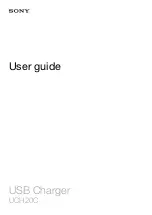
AC Power LED
(blue)
,
Charge Mode
LED
or Charge Monitor
LED
s are not
ON.
Check for loss of AC power at the 240 VAC outlet. Confirm GFCI (Ground Fault Circuit
Interrupter) has not tripped. Check with a meter or 240 VAC test light that AC power is present
at the end or in your extension cord. Reset AC power if it was not present. Confirm all charger
cables are installed with the correct polarity connections at each battery and that all connec-
tions are clean and tight. Wait for 2 minutes until the unit completes analyzing stage.
System Check OK LED
(green) is
OFF
and Troubleshoot
LED
(bank1, bank2 or
bank3) is
ON
(red).
Identify the battery bank LED that is lit, remove AC power and check the battery bank indicated,
for example bank 1, bank 2 or bank 3 (model specific). The LED indicates there is a fault
present. Below are listed typical faults and instructions on how the fault status can be solved:
Note: After making any corrections, reapply AC power.
Poor battery connections
- Make sure all connections are tight and clean.
Blown DC cable fuse
- Use the ohm meter or continuity tester to make sure all
fuses are healthy and visually inspect the DC battery cables to ensure they have
not been compromised or shorted in any manner.
Reverse polarity
- Make sure all wiring connections are color coded and connected properly
and that each bank cable goes to one 12V battery where (+) = red and (-) = black.
Battery too low to charge
- Using a digital voltmeter, make sure the battery is over 2.5 volts
DC. If not, have your battery charged out of the boat and have it load tested by your local
battery dealer to ensure it is safe to charge and that the battery is capable of holding a charge.
High battery voltage input
- Make sure a bank lead has not been spread across 2 batteries
connected in series for 24 volts DC. If so, correct by following the wiring diagrams on pages 13-20.
Battery
(s)
not charging,
AC Power LED
(blue),
Charge Mode
LED
(red)
and Battery Monitor
LEDs
are
ON
Confirm all charger cables are installed with the correct polarity connections at each
battery, and that all connections are clean and tight. Confirm that there are no bank
Battery Trouble Status LED indicators on. With the charger on, read DC voltage at each
battery. If any of the readings are less than 12.8 volts DC, proceed with the following:
A.Disconnect
AC
power at the
240 VAC
outlet.
B.Refer to pages
13-20
in this manual and confirm your charger is connected
correctlyto the battery based on the wiring diagram in Installation section.
C. After completing step B, plug your charger into
AC p
ower and observe the
LED
display. Charger
should be in the charging mode (charging
LED
under Charge Mode is red). In case the batteries were
completely depleted, after completing a full charging cycle that may take up to
10~12
hours or more,
maintaining
LED
(green) under Charge Mode and 5 Charge Monitor
LEDs
(green) are also illuminated.
Note: If a Digital Volt Meter (DVM) is available to you, instead of waiting to complete a full charging
cycle, you can simply use a DVM and take DC voltage measurements across each 12 volts battery.As
long as the voltage continues to increase while the fast charging LED (red) under Charge Mode is on,
this will serve as a confirmation that the charger is properly connected and is properly charging.
Troubleshooting
23
Battery Charger
*For use with trolling motor DC voltages.
IMPORTANT INFORMATION
Models Volts* A mps Batteries AC in
MB3616 12 Amp 12 12 2 /-10% 50 Hz
MB3617 20 Amp 12 20 3 /-10% 50 Hz
Make sure to save and read all safety, operating and installation instructions prior
installing or applying AC power to your Battery Charger.
This product is designed for 12 Volt Flooded and AGM (Absorbed Glass Mat) Lead
Acid batteries. Do not use with any other type of batteries, such as 4D and 8D large
capacity batteries. For other applications, please refer to our website.
Specification
MB3616
Input Voltage: 240VAC
Output Voltage: 12/24V
Input Current: 1.89A
Output Current: 12A @ 12VDC
6A @ 24VDC
Efficiency: 80%
IP Rating: IP68
Cable Length: 1.8m
Dimensions: 262(L) x 176(W) x 72(H)mm
MB3617
Input Voltage: 240VAC
Output Voltage: 12/24/36V
Input Current: 3.13A
Output Current: 20A @ 12VDC
10A @ 24VDC
6.6A @ 36VDC
Efficiency: 80%
IP Rating: IP68
Cable Length: 1.8m
Dimensions: 321(L) x 176(W) x 72(H)mm
Max.qty of 12V






























